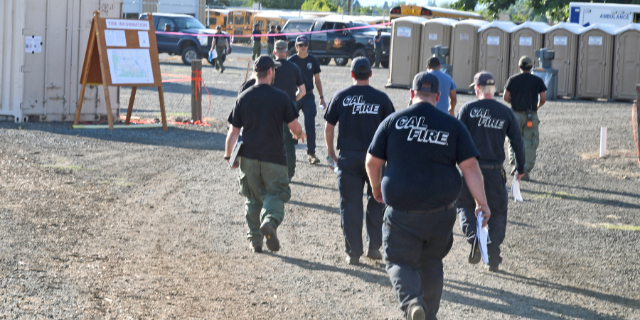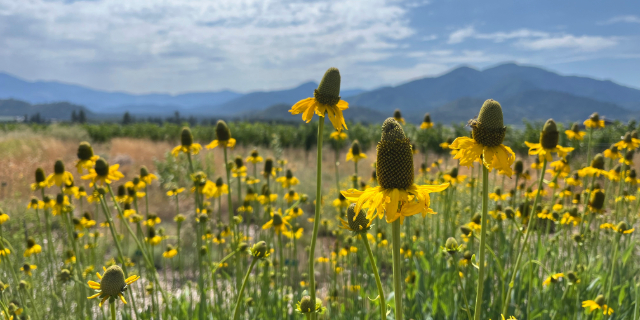GARDEN PLOTS: White-flowered plants make a lovely moonlight garden
Published 6:00 am Wednesday, August 9, 2023

- White camelia: The author grows a variety of white-flowered plants in her garden that would be suitable for a moonlight ornamental garden.
“White clematis, white lavender, anemone and rose
Trending
The lists go and on, my dear, remorse that barely show.
I’ve planted you a garden here, against the pitchy black;
Pure white, my virginal, my owl; pure white,
Trending
Now just — Come back — “
— From Stephanie Barron’s “The White Garden: A Novel of Virginia Woolf,” 2009
For a landscape designer who has come to England on her client’s dime in order to recreate the famous White Garden at Sissinghurst Castle, the protagonist in Stephanie Barron’s (real name Francine Matthews) novel, Jo Bellamy, spends a lot of time away from the garden, chasing the ghost of her grandfather who worked as a gardener on the estate before enlisting as a soldier in World War II.
Jo spends considerably more time unearthing shocking documents written by the novelist Virginia Woolf and her friend and sometime lover, the writer Vita Sackville-West, who was the proprietor of Sissinghurst along with her husband Harold Nicholson from 1930 until her death in 1962. The fictional documents Jo finds throw into question the timeline of Woolf’s drowning in the River Ouse near her home in Sussex and even suggest Woolf may not have committed suicide after all. Woolf’s journal reveals it was Woolf who first suggested the idea for a white garden at Sissinghurst in 1941.
By the end of the book, Jo does manage to compile a plant list and plans for her wealthy client’s white garden back in America. However, readers will be disappointed if they want more than a few snippets of that inventory, which come from Woolf’s journal and a fictional poem written by Sackville-West as a tribute to her friend after her death. Besides the white-flowered plants mentioned in the poem excerpt above, we learn the garden included the trumpet-style regal lily, white lavender, white agapanthus (commonly called Lily of the Nile), and white double primroses.
In fact, Sackville-West and Nicolson began creating the White Garden in the late 1940s/early 1950s — Harold designed the garden, and Vita chose the plants and helped her gardeners put them in. She wrote about their work in her gardening column for the Observer in 1953: “It is great fun and endlessly amusing as an experiment, capable of perennial improvement as you take away the things that don’t fit in, or that don’t satisfy you, and replace them with something you like better.”
A white-flowered garden, often called a moonlight garden, is still one of the most popular color themes among ornamental gardeners, certainly well-deserved admiration due to the way the flowers shimmer in the moonlight, along with the silvery foliage of complementary herbaceous perennials. I’ve found the white and silver-gray plants in my garden glow beautifully just after dusk.
Because the color palette of a white garden is so restricted, it’s important to vary the shape and texture of the plants, and to position them so tall plants don’t hide short ones. Knowing when plants bloom will help to provide moonlit flowers for much of the year. As Nicholson included in his designs, low hedging of dark-green foliage plants, such as yew and boxwood, provides a striking contrast.
Inspired by Barron’s novel, I did a bit of my own sleuthing and came up with a more complete listing of plants in the White Garden at Sissinghurst that would be suitable to grow in our area:
• Rosa mulliganii (species climbing rose): up to 40’, blooms in June
• White gladiolus (such as ‘G. White Prosperity’): 4’-5’, blooms in June-July
• White iris (such as I. ‘Immortality’ bearded iris): 3’, blooms in mid-spring
• White dahlia (such as D. ‘Tiny Treasure’ pompoms): up to 3½’, blooms in late summer-fall
• White foxglove (such as Digitalis purpurea ‘White Camelot’): 3-4’, blooms in summer
• Japanese anemone (such as A. hupehensi ‘Honorine Jobert’): flower stalks up to 4’; blooms late summer-fall
• Baby’s breath (Gypsophila paniculata): 2’-3’, blooms midsummer to fall
• Greek yarrow (Achillea ageratifolia): 4-8” groundcover; blooms in late spring-early summer
• White foxtail lily (such as Eremurus ‘White Beauty’): 4’, blooms late spring-early summer
• White delphinium (such as D. ‘White Guardian’): 2½’-3½’, blooms in June
• White rockrose (such as Cistus x ‘Bennet’s White’): 4’-6’, blooms in spring
• Panicled hydrangea (H. paniculata ‘Grandiflora’): deciduous shrub grows 10-25’, blooms midsummer-fall
• Rock’s tree peony (Paeonia suffruticosa ssp. rockii): up to 5’, blooms in spring
For gardeners who would like to include Oregon natives in their white garden, here’s a partial listing of those that could be grown in partial to full sun:
• Yarrow (Achillea millefolium): up to 3’, blooms June-September
• Western pearly everlasting (Anaphalis margaritacea): 2’-3’, blooms midsummer-fall
• Cascade beardtongue (Penstemon serrulatus ‘Albus’): 3’-4’, blooms June-July
• Sylvan goatsbeard (Aruncus dioicus): 4’-6’, blooms late spring-early summer
• White spiraea (S. betulifolia var. lucida): deciduous shrub 3’-4’, blooms late spring-early summer
• Pacific ninebark (Physocarpus capitatus): deciduous shrub 6’-10’, blooms late spring
• Western mock orange (Philadelphus lewisii): deciduous shrub up to 10’, blooms late spring









